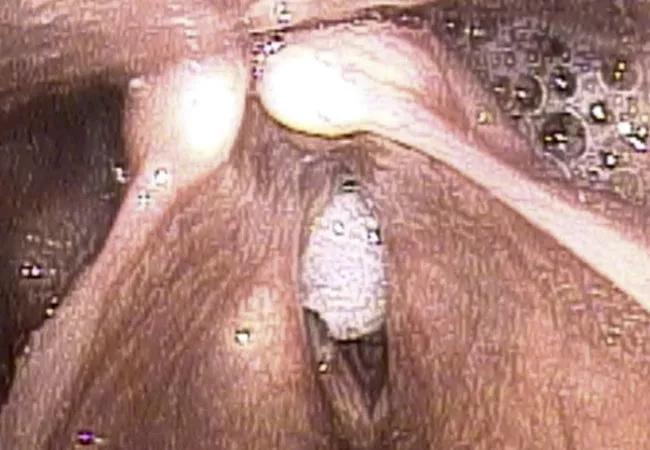New technique is guided by flexible fiberoptic laryngoscopy and uses topical anesthesia

Advertisement
Cleveland Clinic is a non-profit academic medical center. Advertising on our site helps support our mission. We do not endorse non-Cleveland Clinic products or services. Policy
In a recent article published in the American Journal of Otolaryngology, we discuss a new technique for the topical application of mitomycin C (MMC) in an office-based setting, without sedatives. MCC is typically performed in an operating room under general anesthesia as adjuvant treatment in management of laryngeal and tracheal stenosis.
Three patients with glottic and sub-glottic stenosis and bilateral vocal fold immobility underwent successful MMC application in our office following endoscopic airway dilation. All three were men, between the ages of 43 and 65, and had tracheostomies. Two of the three patients had prolonged periods of intubation; the third received chemoradiation for base of tongue squamous cell carcinoma.
Only local anesthesia—topical four percent lidocaine was used—administered directly into the tracheal stoma following removal of the tracheostomy tube. A pledget saturated with MMC (0.4mg/ml) was advanced via a transtracheal approach, and applied to the stenosis using frontal sinus giraffe forceps for 20 to 30 seconds during two to three applications. Placement of the pledget was confirmed using transnasal flexible fiberoptic laryngoscopy.

Decannulation was achieved in two of our patients: one three weeks after the initial MCC procedure and the other 2.5 weeks after the second MMC application. Management of the third patient in this study was delayed for the treatment of advanced prostate cancer.
This is first study to address the use of delayed topical MMC applications, rather than during the dilation procedure, and in an outpatient setting. The MMC procedures were timed to be seven to ten days after dilation, when fibroblast activity is high, as it is intended to blunt the activity of fibroblasts and reduce the amount of scar production.
Advertisement
We performed the procedure on an outpatient basis to limit the risks of anesthesia and costs of the procedure to the patient. Our patients returned home with less down time from work and family, which is especially meaningful in this patient population, as all had previously undergone multiple procedures.
With such a small group of patients, we are interested to see if the delayed timing of the MCC application affects the outcomes for these patients. Specifically, we wanted to see whether or not the patients achieved decannulation, as well as how many and what type of subsequent procedures were required. Next steps in this line of research include identifying additional patients who are candidates and recruiting other surgical centers in an effort to increase the data we have available for analysis.
Laryngeal stenosis is a narrowing of the endolaryngeal airway, commonly at the subglottis. In adults, this is typically iatrogenic from intubation injury with a large endotracheal tube or from prolonged intubation. Incidence is 1-10%, and higher for patients who were intubated more than 10 days. Laryngeal stenosis tends to recur, leading to multiple procedures for patients and our inquiry into the timing of MCC application. MCC, an antibiotic, is an alkylating agent that inhibits fibroblast proliferation. The product was applied in airway surgery for the first time by Ward and April in 1998, and has been proven safe and effective in endoscopic airway surgery.
Paul Bryson, MD, Director of the Cleveland Clinic Voice Center and Section Head of Laryngology, is an otolaryngologist who specializes in voice and swallowing rehabilitation. He completed his fellowship at Massachusetts General Hospital Center for Laryngeal Surgery/Voice Rehabilitation.
Advertisement
Images from: Merea VS, Paul B. Office-based retrograde transtracheal application of mitomycin C. American Journal of Otolaryngology. 2018:39(6);704-706, with permission from Elsevier.
Advertisement
Advertisement

Case study illustrates the potential of a dual-subspecialist approach

Evidence-based recommendations for balancing cancer control with quality of life

Study shows no negative impact for individuals with better contralateral ear performance

HNS device offers new solution for those struggling with CPAP

Patient with cerebral palsy undergoes life-saving tumor resection

Specialists are increasingly relying on otolaryngologists for evaluation and treatment of the complex condition

Detailed surgical process uncovers extensive middle ear damage causing severe pain and pressure.

Despite advancements in the specialty, patient-centered care needs to remain a priority